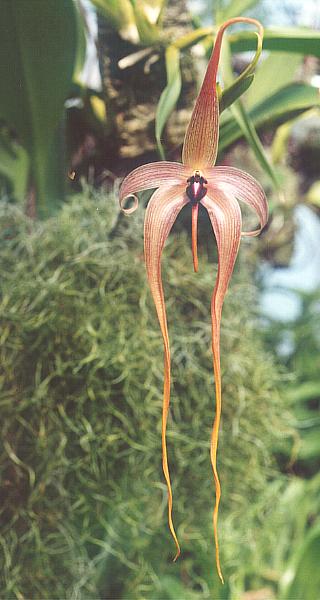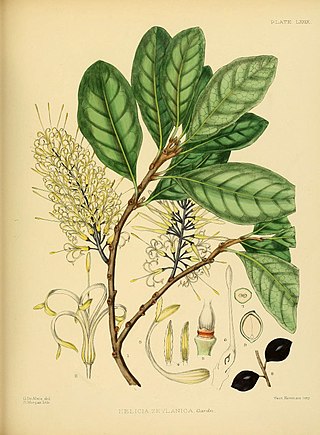
Bulbophyllum is a genus of mostly epiphytic and lithophytic orchids in the family Orchidaceae. It is the largest genus in the orchid family and one of the largest genera of flowering plants with more than 2,000 species, exceeded in number only by Astragalus. These orchids are found in diverse habitats throughout most of the warmer parts of the world including Africa, southern Asia, Latin America, the West Indies, and various islands in the Indian and Pacific Oceans. Orchids in this genus have thread-like or fibrous roots that creep over the surface of trees or rocks or hang from branches. The stem is divided into a rhizome and a pseudobulb, a feature that distinguished this genus from Dendrobium. There is usually only a single leaf at the top of the pseudobulb and from one to many flowers are arranged along an unbranched flowering stem that arises from the base of the pseudobulb. Several attempts have been made to separate Bulbophyllum into smaller genera, but most have not been accepted by the World Checklist of Selected Plant Families.

Nyctanthes arbor-tristis is a species of Nyctanthes native to South Asia and Southeast Asia. It is commonly known as night-blooming jasmine, tree of sadness, tree of sorrow, coral jasmine and in Singapore seri gading. Despite its common name, the species is not a "true jasmine" and not of the genus Jasminum.

Dipterocarpus retusus, commonly known as hollong, is a large tree and perhaps the best known species in the genus Dipterocarpus. It is native to China, Vietnam, Philippines, Laos, Cambodia, Malaysia, Indonesia, Myanmar, and India. The tree, some 20–30 metres (70–100 ft) tall, is found in Cambodia in dense forests of the plains, common on hillsides and along rivers and in forests between 800 m (2,600 ft) and 1,500 m (5,000 ft) altitude.

Platyplectrurus madurensis, commonly known as the Travancore Hills thorntail snake, Palni purple-brown worm thorntail snake, or Madurai shield-tail snake, is a species of uropeltid snake. It is found in southern India and, depending on the source, Sri Lanka.

Corypha umbraculifera, the talipot palm, is a species of palm native to eastern and southern India and Sri Lanka. It is also grown in Cambodia, Myanmar, Thailand and the Andaman Islands. It is one of the five accepted species in the genus Corypha. It is a flowering plant with the largest inflorescence in the world. It lives up to 60 years before bearing flowers and fruits. It dies shortly after.

Ruellia is a genus of flowering plants commonly known as ruellias or wild petunias. They are not closely related to petunias (Petunia) although both genera belong to the same euasterid clade. The genus was named in honor of Jean Ruelle (1474–1537), herbalist and physician to Francis I of France and translator of several works of Dioscorides.

Hygrophila, commonly known as swampweeds, is a genus of flowering plants in the acanthus family, Acanthaceae. There are about 80 to 100 species, of which many are aquatic plants. The genus is distributed across the tropical and subtropical world. It is one of only two genera in its family that contains aquatic plants, the other being Justicia. The genus is treated in the tribe Hygrophileae, which is noted as being in need of revision at the genus level, meaning the current taxonomic boundaries of Hygrophila are likely to change in the future.

Carpoxylon macrospermum is a species of palm tree endemic to Vanuatu, and the only species in the genus Carpoxylon.

Satakentia liukiuensis, is a species of palm tree. They are endemic to Ishigaki Island and Iriomote Island in the Yaeyama Islands, the south-westernmost of the Ryukyu Islands, Japan. It is the only species in the genus Satakentia.

Helicia is a genus of 110 species of trees and shrubs, constituting part of the plant family Proteaceae. They grow naturally in rainforests throughout tropical South and Southeast Asia, including India, Sri Lanka, Indochina, Peninsular Malaysia to New Guinea and as far south as New South Wales.
Hygrophila gracillima is a species of plant in the family Acanthaceae. It is found in Namibia and possibly Angola. Its natural habitats are intermittent rivers and intermittent freshwater marshes. It is threatened by habitat loss.
Oxanthera brevipes is a species of plant in the family Rutaceae. It is endemic to New Caledonia. It was proposed as a novel species by Benjamin C. Stone based on two specimens, distinguished from other false oranges by a non-articulated petiole. The genus Oxanthera has been synonymized with Citrus, but a name in Citrus does not appear to have been published, and Plants of the World Online regards "Oxanthera brevipes" as an unplaced name.
Citrus neocaledonica, synonym Oxanthera neocaledonica, the large leaf oxanthera, is a species of plant in the family Rutaceae. It is endemic to New Caledonia.

Barringtonia asiatica is a species of Barringtonia native to mangrove habitats from islands of the Indian Ocean in the west to tropical Asia and islands of the western Pacific Ocean. It is grown along streets for decorative and shade purposes in some parts of India, for instance in some towns on the southeastern shore. It is also known as Box Fruit due to the distinct box-shaped fruit it produces. The local name futu is the source of the name for the Polynesian island Futuna. The type specimen was collected by botanist Pehr Osbeck on a sandy beach area on the island of Java, later to be described by Carl Linnaeus in his Species Plantarum in 1753.

Hygrophila polysperma, commonly known as dwarf hygrophila, dwarf hygro, Miramar weed, Indian swampweed or Indian waterweed, is an aquatic plant in the family Acanthaceae. It is native to Bangladesh, India, China and Malaysia, and has also been introduced to the US states of Florida, Texas and possibly Virginia. It is listed on the Federal Noxious Weed List in the US and is illegal to import and sell in a number of states including Kansas and South Carolina.

Hygrophila auriculata is a herbaceous, medicinal plant in the acanthus family that grows in marshy places and is native to tropical Asia and Africa. In India it is commonly known as kokilaksha or gokulakanta, in Sri Lanka as neeramulli. In Kerala it is called vayalchulli (വയൽച്ചുളളി). In Tamil it is called Neermulli (நீர்முள்ளி).

Crateva is a genus of flowering plants in the caper family, Capparaceae. It includes 21 species which range through the tropical regions of the world, including the tropical Americas, sub-Saharan Africa, the Indian subcontinent, Indochina, southern China, Japan, Malesia, Papuasia, Queensland, and the South Pacific.

The Madura horseshoe bat is a species of bat from the family Rhinolophidae. Current taxonomy treats the Madura horseshoe bat as a species separate of the Sulawesi horseshoe bat and not including parvus, but Csorba et al. (2003) recognizes both as subspecies of the Sulawesi horseshoe bat. It is known only from seven specimens from Madura Island and the Kangean Islands in Indonesia, and its type locality is Soemenep, Madura Island. The species is listed as Vulnerable on the IUCN Red List, and it suffers from habitat loss due to limestone excavation and deforestation for logging and agriculture in its habitat. It is also unknown whether or not the Madura horseshoe bat lives in any protected areas. The species is cave-roosting and most likely independent of water, foraging in primary forest.

Uropeltis madurensis, also known commonly as the Madura earth snake and the Madurai shieldtail, is an endangered species of small, fossorial, nonvenomous snake of the family Uropeltidae. The species is endemic to the Western Ghats of South India.















